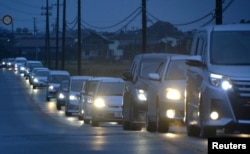The 7.4 magnitude earthquake and small tsunami that struck Japan’s northeast coast on Tuesday morning tested the sea wall constructed around the Fukushima nuclear plant, that was the site of one of the worst nuclear catastrophes in history.
The earthquake hit at early morning and was centered off the coast of the Fukushima Prefecture at a depth of about 10 kilometers, according to the Japan Meteorological Agency.
The Pacific Tsunami Warning Center said the first wave of the tsunami was measured at 90 centimeters, then the waves died down. About an hour and a half after the earthquake there was also 1.4 meter wave that was large enough to cause some flooding.
Japanese television showed tsunami waves flowing up rivers in some areas, and some fishing boats were overturned in the port of Higashi-Matsushima.
Reports of injuries and damage from Tuesday’s earthquake and tsunami were minimal. Residents in the region evacuated to higher ground after tsunami warning sirens sounded in the early morning and many ships moved out to sea to ride out the incoming ocean surge.
Magnitude
While the Japan Meteorological Agency calculated the earthquake’s magnitude at 7.4, the U.S. Geological Survey (USGS) measured it to be a 6.9 quake.
Tuesday’s earthquake was much less powerful than the 9.0 earthquake that struck the same region in March of 2011, generating enormous tsunami waves, some as high a 40 meters, that killed close to 20,000 people and caused the meltdown of the Fukushima Nuclear Power Plant, the worst nuclear crisis since Chernobyl a quarter of a century earlier.
Geophysicist Rafael Abreu with the USGS Earthquake Information Center says a one magnitude point rise on the seismic scale equals a 32 time increase in destructive power released during an earthquake.
“The magnitude of a 9.0 quake is an earthquake that released 32×32, over 1,000 times more energy then the quake that we had today,” said Abreu.
Fukushima
The Fukushima nuclear reactors that were damaged during the 2011 meltdown have been since shut down, but the Tokyo Electric Power Company (TEPCO) still maintains cooling systems to prevent the spent nuclear material from overheating and spewing radioactive waste into the air and ocean.
Naohiro Masuda, head of TEPCO’s Decommissioning Unit, said on Tuesday a one-meter tsunami was observed from two Fukushima nuclear power plants but precautions were taken to prevent a possible breech.
"With regards to Fukushima plant No. 1, it appears to be there is no problem inthe plant, but we proactively stopped operation of the contaminated water discharge system with a judgement that it could be problematic if it (radioactive water) leaks out," he said.
In 2015, TEPCO competed a 780-meter coastal sea wall around the heavily damaged reactor buildings of the Fukushima No. 1 plant to reduce the amount of contaminated water flowing into the ocean. During the worst of the crisis it was leaking 400 tons of radioactive water a day.
An ice wall has also been constructed to reduce the amount of water flowing into the nuclear plant from the nearby mountains.
Kendra Olrich, a Senior Global Energy Campaigner with the environmentalist organization Greenpeace in Japan, said the sea wall fared relatively well this time but Tuesday’s earthquake illustrates that Japan is too geologically unstable to safely operate nuclear power plants.
“All of these earthquakes continue to highlight the absurdity of having nuclear power in a country that is sitting on the Pacific ring of fire,” she said.
Inside the damaged Fukushima plants, efforts are still underway to remove the molten nuclear core and move the highly radioactive materials to a safer storage facility.
Olrich said radioactive contamination that seeped into the surrounding forests during the tsunami five years ago continue to pose a danger to public health and safety. She is also critical of government plans to lift evacuation orders in affected areas next year that would end TEPCO’s obligation to provide compensation, at the cost of potentially exposing residents to increased risks.
Youmi Kim contributed to this report.









